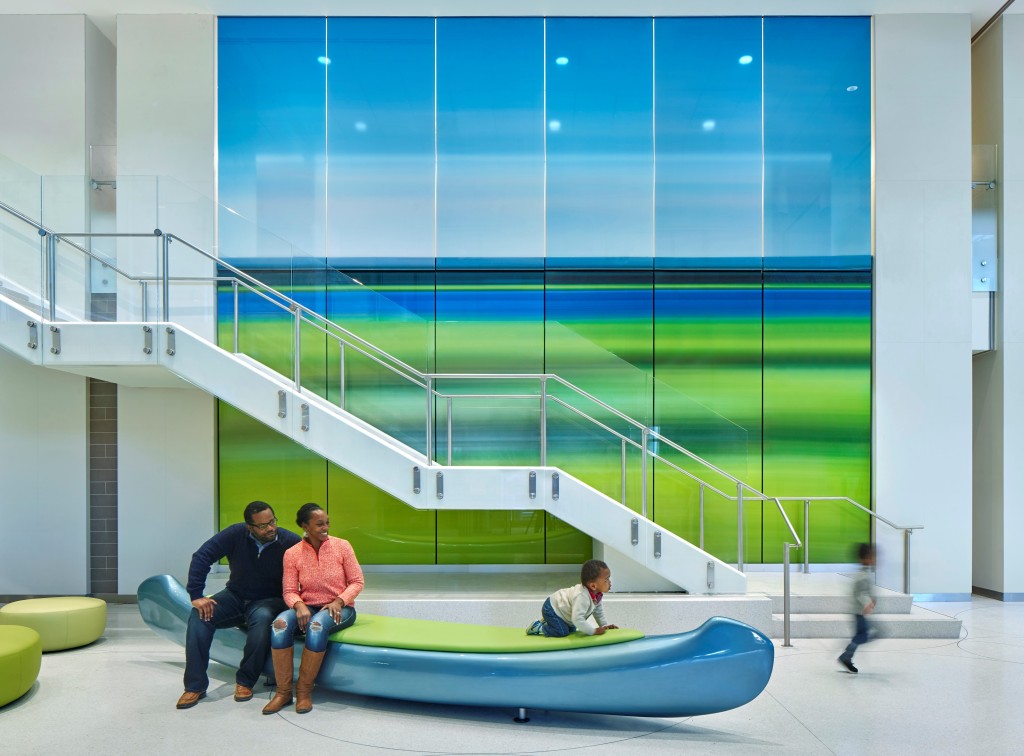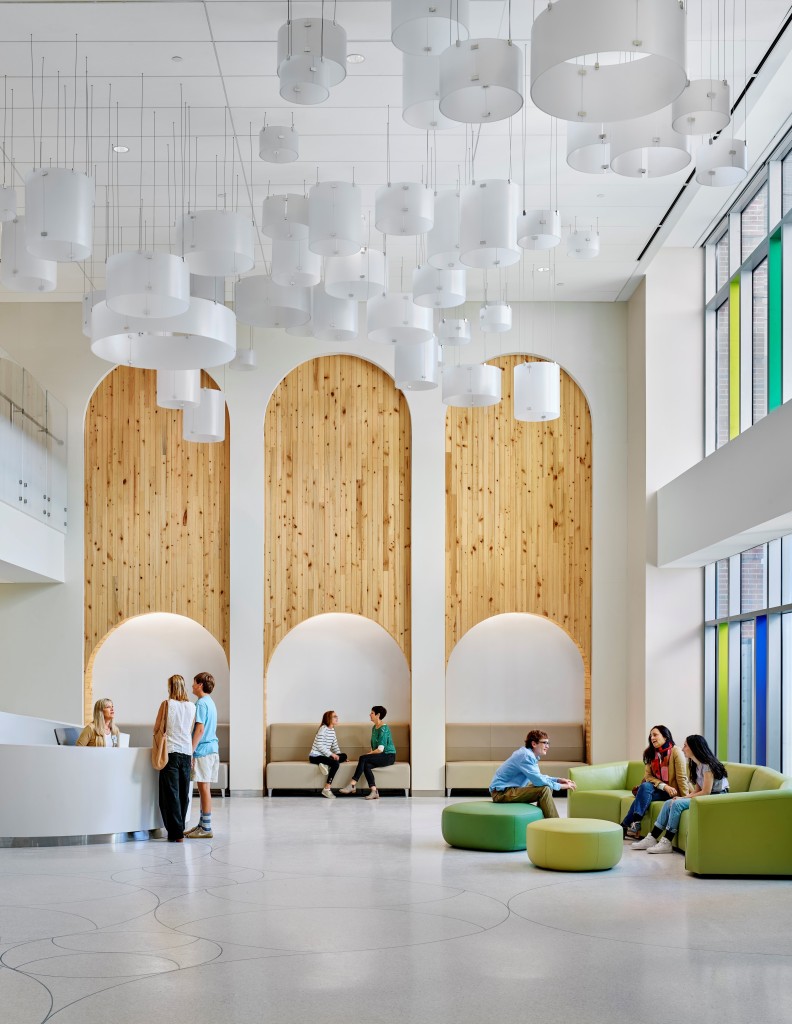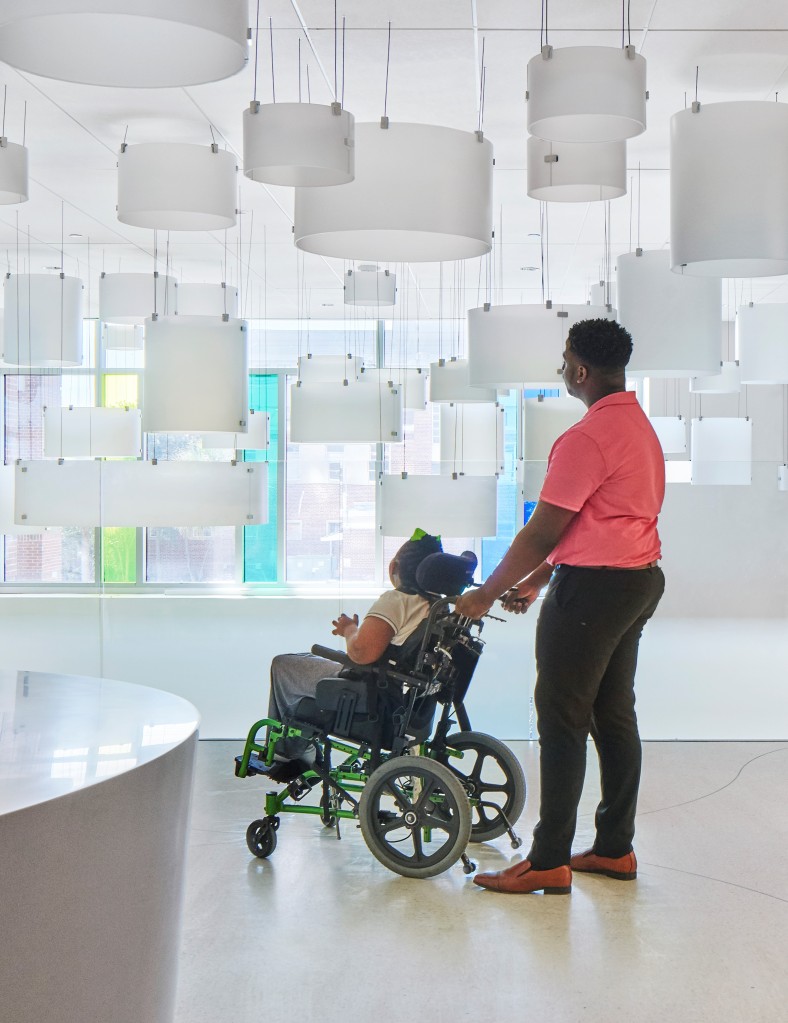The COVID-19 pandemic is having a profound impact on the world around us, touching all of our lives and heightening awareness of the importance of healthcare and healthcare environments. In this interview, Carolyn BaRoss, IIDA, the New York-based firmwide healthcare interior design director at Perkins and Will, shares her thoughts on how the firm and her healthcare design practice has adjusted, and how they will move forward in a new normal. She offers lessons that can be applicable to all interior designers and architects, not just those focused on healthcare.
IIDA: How have your teams and colleagues adjusted to working remotely and continuing their projects?
Carolyn BaRoss: Within our firm, we have genuine concern for each other’s well-being and safety, and gratitude for the ability to continue to work and create together remotely through our firm’s robust technology infrastructure. Overcommunication and clarity of communication—that is, communicating clearly and often—is a highly effective rule of thumb, particularly when a project is just getting started. But once things get moving, compassion is key: we understand and accept the need for personal flexibility and shifting work schedules, because there are unique challenges for everyone. We know our people are doing their best.
IIDA: How has the firm implemented technology to both continue the work as well as to encourage communication and continued collaboration?
CB: We benefit from a suite of digital project and collaboration management tools that help keep everyone engaged and thriving with some semblance of normalcy. Here in New York, we continue to gather the entire studio for our Monday morning “all hands” meeting, where multiple studio leaders present updates, and we continue to hold project team meetings, just as we always have. More recently, our firm has introduced a series of cross-disciplinary meetings with diverse practice leaders from all over the world during which we share ideas and strategies for our “new normal”—today and in the future. And finally, formerly “analog” culture and community events that help us connect on a personal level have now gone digital, including virtual coffee breaks and tea time, shared movies, group yoga, and design dialogues.
IIDA: Is there an aspect of your firm’s workflow that has not drastically changed in this time?
CB: We’ve always done work in China by virtual collaboration between our Shanghai and New York teams, for example. One project in China, which had been delayed due to the COVID-19 outbreak, is now ramped back up as people return to the workplace there.
“One of the silver linings is that the COVID-19 pandemic has revealed an intrinsic global community interconnectedness. Ultimately, helping and being part of the solution matters most—whether you’re a designer or not.”
– Carolyn BaRoss
IIDA: Your firm has strong research-based approaches and initiatives. How is that informing your approach to the work at this time?
The urgency for factual, evidence-based strategies has led to collaboration between our healthcare interiors team and our firm’s commercial interiors clients and colleagues. This convergence of practices has been positive for a number of reasons, not the least of which is a sharing of our healthcare research and technical knowledge, including designers, and that of clinically trained nursing leadership within our firm. Suddenly, healthcare interior design best practices are human health best practices, relevant for all building types, touching everything from space planning, materiality, and detailing to technology, engineering systems, and operations.
We see this both as an extraordinary opportunity and as a responsibility. We are sharing scientific research and knowledge, but our goal is to ensure that this research and knowledge are used appropriately and intelligently in support of “do-no-harm” protocols. We are somewhat concerned that the fear generated by COVID-19 and community spread will prompt emotional, partially-informed reactions that may actually cause more harm than good over time—for example, the inappropriate use of antibacterial and antimicrobial products.
IIDA: At this moment, many of your healthcare clients in the U.S. are overwhelmed with work that is focused on the immediate crisis. How do you continue the communication process to move design projects forward with them?
CB: We have altered the format and abbreviated communications into smaller pieces so that clinical leadership can review and respond during breaks, while handling the COVID-19 crisis. Instead of stopping project work, we have heard that breaking up their days this way has given them a moment to think optimistically about building a positive future, and it’s been a welcome respite from the present crisis. We already had established a good rapport with the client team, so virtual and truncated communications remain effective for this period.
One change we are seeing on the clients’ side is the way they’re delivering care to their patients. For non-COVID-19 care teams like elective/specialty care services, there’s a slowdown in patient flow. Non-emergency ambulatory clinics are closed, and their caregivers are available via telemedicine portals. Some have furloughed health system employees and or reduced salaries. I have also heard of physicians experiencing a significant reduction in hours.
IIDA: How is Perkins and Will engaged in strategic-response design through the adaptation of existing healthcare facilities or repurposing for surge capacity?
The firm has several initiatives, each of them driven by how the virus has impacted a given studio’s location, and many of them are really tapping into the creative power of design thinking.
- Our Seattle studio has been working with Swedish Medical Center to create a digital dashboard that aggregates critical data in real-time from their regional hospital network. The data includes hospital space usage, bed availability, health statistics from national databases, availability of medical gases, and the sanitization of space and equipment. It is necessary for making smart, split-second decisions. Rather than waiting for drawings to be printed up and presented, a real-time digital dashboard presents the data in a cohesive, visually compelling, easy-to-interpret way. This groundbreaking work is currently being beta-tested with the client, and our firm’s IT team is heavily involved. Our Seattle team has also been working with Swedish on quick-response and temporary efforts to accommodate an influx of patients including building out temporary new spaces to accommodate additional beds.
- In New York, we have been working with the Greater New York Hospital Association (GNYHA) Surge Capacity Task Force. In March, New York State called for the creation of nearly 140,000 additional acute care and intensive care unit beds within 14 to 21 days. We’ve been helping to rapidly assess unused hospital-owned spaces, long-term care facilities, and alternative care sites, like hotels and commercial real estate, to increase hospital bed capacity by between 50 and 100 percent. We are also involved in a similar task force in New England.
- In the Chicago area, our COVID-19 work includes converting existing buildings into alternative care facilities. One project will reactivate a former acute-care hospital to treat COVID-19 patients, and another will transform a former medical office building into a dedicated COVID-19 care facility.
- In San Francisco, we assessed the viability of converting a hotel into a COVID-19 care facility.
- Our Copenhagen, Boston, Miami, Chicago, and Dallas studios—among others—are designing and creating no-cost personal protective equipment (PPE) for our healthcare clients.
“Suddenly, healthcare interior design best practices are human health best practices, relevant for all building types, touching everything from space planning, materiality, and detailing to technology, engineering systems, and operations.”
– Carolyn BaRoss
IIDA: How has your firm’s best practices positioned your healthcare team for the important design work that they do, now and post-COVID-19?
We think holistically about resilience in our health facilities and design proactively for health and well-being while avoiding damage to the environment, public health and health policy, and the health of our communities. We aim to design effectively for circumstances like pandemics involving all kinds of illnesses, severe weather events, and acts of violence. As part of this, considerations for healthcare interiors include the following, some of which are already best practice:
- Surge capacity flexibility and adaptability of current and new healthcare and non-healthcare facilities that are proximate to hospitals where staffing and logistical support can be made available.
- Cleanability and ability to disinfect, including the use of UV lighting, easily-wipeable surfaces, and materials and detailing made to withstand rigorous cleaning protocols like vaporization.
- Hands-free, touchless technologies and design solutions.
- Understanding the causes of, and means of transmission of different illnesses, and the need to respond appropriately.
- Balancing the natural environment within our built environment, and enabling our microbiome to help combat germs without inadvertently creating or worsening a problem.
- Designing and allowing for caregiver respite and well-being: the stressors currently placed on our caregivers, and the dangers they face, urgently require intervention.
- Configuration and airflow of arrival spaces in healthcare for prevention, screening, and triage in order to isolate and prevent germ transmission into other areas.
- Storage capacity and emergency storage in preparation for disruptions in the supply chain.
IIDA: Taking this moment of crisis into consideration, what does the future for healthcare design hold once we are able to return to a feeling of normalcy?
CB: We have to strongly consider what this new, post-pandemic world will look like; how the economic fallout will impact the future of healthcare facilities; what the medical side effects for survivors will be; and what the future holds for affordable and accessible patient care.
One of the starkest lessons and opportunities that COVID-19 brings to light is that public health crises can systematically disadvantage essential workers, first responders, those with pre-existing conditions, and the economically disadvantaged in crowded living situations. The question is, how will we apply that lesson to enable adequate and equitable community prevention, testing, telemedicine, and care in the future? We’re all in this together, and we need to address it together.
IIDA: Do you foresee lessons from healthcare interiors impacting the design of other project types, such as workplace?
CB: Absolutely. One of the most compelling ways our practice has been impacted by the COVID-19 pandemic is the extent of which non-healthcare (namely: corporate interiors) clients are clamoring for healthcare-specific infection control strategies to ameliorate spaces ensuring building occupant safety. We are also applying healthcare infection control best-practices in other built environments. This is a very good thing, if the design solutions are effective, researched, and supported by scientific data.
IIDA: Reflecting on this moment in time and your experience in recent weeks, what is your big-picture perspective on how we can move forward, together?
CB: One of the silver linings is that the COVID-19 pandemic has revealed an intrinsic global community interconnectedness. Ultimately, helping and being part of the solution matters most—whether you’re a designer or not—from making masks to staying home, or caring for others. Truth is essential. For those of us who happen to specialize in designing interior healthcare environments, we know how valuable our technical knowledge and research is to people and markets outside our own, and we recognize how urgent unity is. Right now, competitors are working together rather than in opposition, researchers are investigating how we can do better as a global society, And civic-mindedness has taken center stage above all else. Does this represent a turning point, a permanent shift toward collaboratively protecting our environment and public health? I hope so. It takes something like this to snap us out of our complacency and to remind us that the problem isn’t abstract anymore, or just a future model that may or may not happen. By working together, we can accomplish so much more.
In response to our rapidly changing world, IIDA brings you a design-focused dialogue on the effects of a global crisis. Join us for this important community discussion. Collective D(esign) Episode Five | Hospitality Design in a New Normal takes place on April 24, learn more about the series here.







